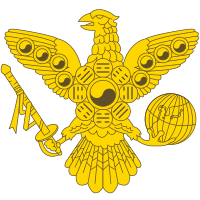Sello Imperial de Corea
| Sello Imperial de Corea | ||
|---|---|---|
| Escudo en desuso | ||
 | ||
| Información | ||
| Entidad |
| |
| Propietario | Casa de Yi | |
| Fecha de adopción | ¿1903? | |
El Sello Imperial de Corea (대한제국의 국장 en coreano) o Ihwamun (이화문 en coreano) fue uno de los símbolos del Imperio de Corea. Originalmente fue el emblema de la familia imperial y posteriormente fue utilizado para el escudo del imperio de corta duración. El símbolo cuenta con una flor de ciruelo (en hangul, 이화; en hanja, 李花; romanización revisada del coreano, Ihwa; McCune-Reischauer, Ihwa), También conocido como Maehwa, que señala el comienzo de la primavera en Corea.[1] La flor del ciruelo se consideraba un símbolo de valentía frente a las dificultades, especialmente en algo tan físicamente delicado, y ha sido admirada durante mucho tiempo en la literatura coreana y china.[2] A medida que el ciruelo florece entre dos estaciones, también se considera un símbolo de la primavera, que aporta calidez, transición y la promesa de fecundidad.[3]
| Emblema Imperial de Corea | ||
|---|---|---|
| Escudo en desuso | ||
 | ||
| Información | ||
| Entidad |
| |
| Propietario | Emperador de Corea | |
| Fecha de adopción | 1903 | |
Desde la antigüedad, la flor del ciruelo ha estado llena de significado y misterio. Las flores de ciruelo florecen al final del invierno y, por eso, se les llama el heraldo de la primavera. También simbolizan la perseverancia porque pueden florecer durante el frío invierno. Al ser consideradas la primera flor del año, también representan pureza y renovación. Las flores de ciruelo tienen cinco pétalos que se cree que transmiten 5 bendiciones diferentes, como riqueza, salud, virtud, paz y muerte natural.[4]
-
Seokjojeon, Deoksugung en Seúl.
-
½ jeon. Moneda del Imperio de Corea (1909).
Véase también
[editar]Referencias
[editar]- ↑ «When spring blooms in Korea». Korea.net. Archivado desde el original el 4 de mayo de 2022. Consultado el 4 de mayo de 2022.
- ↑ Kim, Sunglim (2018). Flowering plums and curio cabinets: the culture of objects in late Chosŏn Korean art. Korean studies of the Henry M. Jackson School of International Studies. Seattle: University of Washington Press. ISBN 978-0-295-74341-7.
- ↑ «Every Plum tree has a story...». The Present Tree (en inglés). Consultado el 19 de mayo de 2023.
- ↑ «Plum Blossoms, its Symbolism and Meanings». Lotus Fun (en inglés). Consultado el 19 de mayo de 2023.
Text is available under the CC BY-SA 4.0 license; additional terms may apply.
Images, videos and audio are available under their respective licenses.


